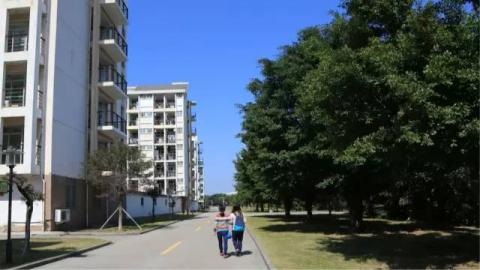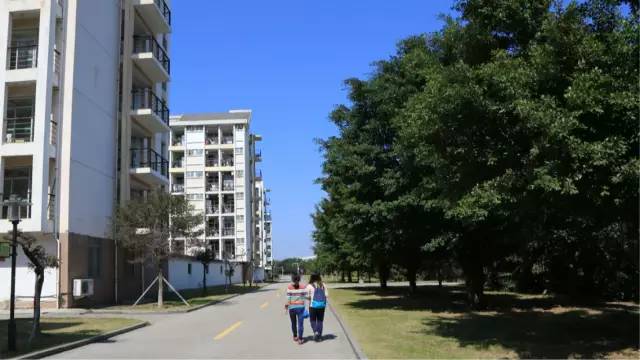
After watching the sunrise with flowers and bamboos, we decided not to stay in Xiapu and go directly to Fuzhou.
My daughter has been studying in Fuzhou for almost 4 years and I have never been there. I visited my son once in the first semester when he went to Kunming to study. I didn’t go there again until he went to Chengdu to study. In order to show "fairness", let's take this opportunity to visit our daughter's school.
The journey went smoothly, except that my daughter said it was too late when it was time to turn when entering the school gate, and the car drove directly onto the overpass, so I had to make an extra circle. I parked my car in front of the dormitory, and it was almost 12:30. I said I was going to eat in my daughter’s cafeteria. During the Chinese New Year, I didn’t expect that there was actually a stall open. It was a huge canteen. There were 3 or 5 people eating when we entered. The stall was run by a young couple. Today there was only noodles. We ordered three bowls in the highest order. Unexpectedly, the three bowls were so big that we couldn't finish them. When the noodles were served, we were the only ones left in the cafeteria. Although the background music system was poor, it was still soft. The background music was not turned off until we finished eating, and the door to the cafeteria was locked immediately after we walked out, but they never rushed us, and we were very grateful for their patience.
I wanted to take some of my daughter's things home, but the dormitory door was locked, so I had to give up. 

After settling in and taking a short rest, I asked my daughter to go to the so-called Three Lanes and Seven Alleys many times. A person from Fuzhou took us on a tour, but as we hadn't done our homework, we actually missed the entrance to the Lin Zexu Memorial Hall.
As soon as I arrived at the south entrance of Nanhou Street, the streets were crowded with people and the sound of selling goods was everywhere, which greatly reduced my interest. I walked along four streets, including Gongxiang, Wenrufang, Huangxiang and Langguanxiang. Each street was very quiet and there were not many tourists. It was a pity that people just walked around the streets and no one went to understand them in depth. This is also the sadness of these historical sites in the current economic tide - even people like me who are so-called more concerned about history are just taking a quick look.



Three Lanes and Seven Alleys is the abbreviation of the ten lanes and lanes arranged from north to south on both sides of Nanhou Street in Gulou District, Fuzhou City. The three sections of South Back Street to the west are called "lanes", and the seven sections to the east are called "lanes". From north to south are the "three lanes" of Yijin Lane, Wenru Lane, Guanglu Lane, Yangqiao Lane, Langguan Lane, The "seven lanes" are Anmin Lane, Huang Lane, Tower Lane, Gong Lane and Jipi Lane.
Three Lanes and Seven Alleys as a whole is a large community with strong ancient style. It is the largest existing and most complete historical and cultural block in China. It is a unique ancient architectural relic in the country. It basically retains the pattern of lanes and lanes in the Tang and Song Dynasties. It is rare in the country and has 9 national buildings. It is a key cultural relic protection unit, 8 Fujian provincial cultural relic protection units, and 131 historical buildings are protected. It is "the living fossil of the city's lifang system" and is known as the "Ming and Qing Architectural Museum". At the same time, there are 6 national intangible cultural heritages here, including Fujian opera, Shoushan stone carvings, and bodiless lacquerware.
Three Lanes and Seven Alleys is also a gathering place for celebrities in modern China, and is known as "One Three Lanes and Seven Alleys, half of China's modern history." Modern celebrities such as Lin Zexu, Yan Fu, Lin Juemin, Shen Baozhen, Sa Zhenbing, Bing Xin, etc. all came from here. A total of 3 navy chiefs, 10 ministers, 10 governors, 10 academicians and 151 Jinshi have lived here.
The houses in Sanfangqixiang follow the tradition of building walls in sections in the late Tang Dynasty, and all have high and thick brick or earth walls. The wall is streamlined with the ups and downs of the wooden roof trusses, and the corners extend out of the house, resembling a saddle, and is commonly known as the saddle wall. The wall is only used as the outer perimeter, and the load-bearing function lies entirely in the columns. They are generally symmetrical on both sides, and the wall tops and wing corners are painted with clay sculptures, forming a unique wall style of ancient Fuzhou dwellings. The house has one or more entrances, and each entrance has a hall, a back hall, a main room, a back room, left and right pavilions, and front and rear patios. Patios are another feature of traditional houses in Fuzhou. It is a rectangular space surrounded by corridors in the hall and pavilions. It serves as a transportation hub in the house and provides the house with sufficient sunlight, smooth air and convenient drainage. The indoor doors and windows are also different from other places, they are numerous and large. Most of the windows are double-layered long row windows, with the bottom layer being fixed and the upper layer being expandable or double-opening. The main door of the main house faces the hall corridor, which is mostly four-opening style. The door is carved with rich patterns and flowers to add to the grandeur of the hall. "Who would have thought that a guest with five willows and a solitary pine tree would live among three lanes and seven lanes." The three lanes and seven lanes are home to outstanding people, generals and prime ministers. Many famous politicians, military strategists, writers, and poets in the past dynasties came to glory from here. The names of some streets and alleys can reveal the grace and glory of those years.
Gongxiang, which can be said to be the gathering place for Lin Zexu’s sons and sons-in-law, has the former residence of Shen Baozhen [1820-1879, Jinshi in the 21st year of Daoguang, Lin Zexu’s second son-in-law, who served as minister of shipping in Fujian, and became governor of Liangjiang and minister of Nanyang Commerce]; Liu Qi’s title [ 1815-1877, Jinshi in the 21st year of Daoguang, Lin Zexu's eldest son-in-law, and his official position was governor of Henan] former residence; Lin Congyi [1824-1878, Lin Zexu's son, served successively as secretary of the cabinet, director of the six ministries, prefect of Quzhou, Zhejiang Buyongdao, department The former residence of Zhejiang's envoy, Hangjiahu Coast Guard and other officials. Lin Bingzhang [1875-1923, Jinshi in the 20th year of Guangxu, grandson of Lin Congyi, eldest son-in-law of Chen Baochen, former director of the Department of Finance of Fujian Province, supervisor of Fujian Customs, etc.]; Lin Xiang [1881-1935, Doctor of Laws at Meiji University, Japan , the former residence of Lin Congyi, grandson of Lin Congyi, who successively served as the Prosecutor General of the General Prosecutor's Office of the Military Government of the Republic of China, Director of the Special Criminal Trial Office, President of the Supreme Court, and Minister of the Civil Service Department of the Examination Yuan; and Liu Guanxiong [1857-? , the former residence of the Navy Commander-in-Chief of the Republic of China; anyone who is slightly familiar with modern Chinese history knows this prominent reputation.
Wenrufang The name Wenrufang came into existence during the Song Dynasty. Gan Guobao, the famous general of the Qing Dynasty, the Admiral of Fujian and Taiwan's commander-in-chief, also lived here. The former residence of Chen Chengqiu, the home of the "People's Jinshi" (a Jinshi in the capital of the Five Dynasties) who was famous throughout the Qing Dynasty, is also in the square. Chen Chengqiu's eldest son was Chen Baochen, the teacher of Emperor Xuantong of the Qing Dynasty. The former residence of Chen Yan, a famous poet in the Qing Dynasty and the author of "Shi Shi Shi Hua", is also in the square. It is a large house facing south. There is Guanghua Pavilion inside, which is used to provide lessons for the disciples who entered the house. Next door to Chen Apartment is the residence of Professor Ke Linghan, a famous modern legal scholar. This street is famous for the emergence of numerous scholars in the past dynasties.
The commemorative monument at the street entrance is embedded on the north wall of the east entrance of Wenrufang. Since the seventh year of Guangxu in the Qing Dynasty (1881) to the present, it has weathered the wind and rain for more than a hundred years, watching the backs of countless passers-by, and the handwriting is still clear. It is very rare to find it in perfect condition. The monument is 2.2 meters high, 0.8 meters wide, and is rectangular. The inscription reads: "Within the walls of the square, it is not allowed to open the door privately, worship gods and Buddhas, build shelters, or post objects to prevent danger; it is forbidden to arrange wood and other objects in the official streets of Sanshe. In the reign of Emperor Xin of Guangxu, wen Confucian Square made a convention. " This is the only remaining ancient village in Fuzhou and a rare monument in small streets and alleys in cities across the country. When people in the neighborhood come and go, doesn't the monument serve as a warning or a reference?
After coming out of Sanfangqixiang, we ate steak at the street entrance. Since it was not far from where we lived, the family took a stroll back. As we were approaching the hotel, it started to rain.
